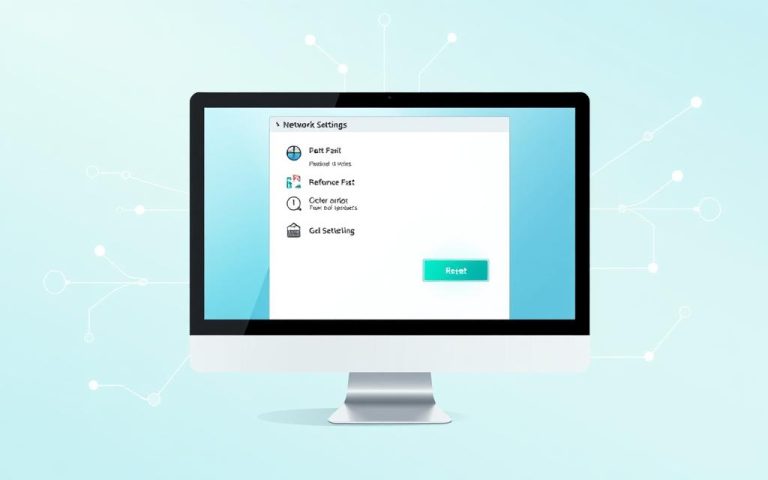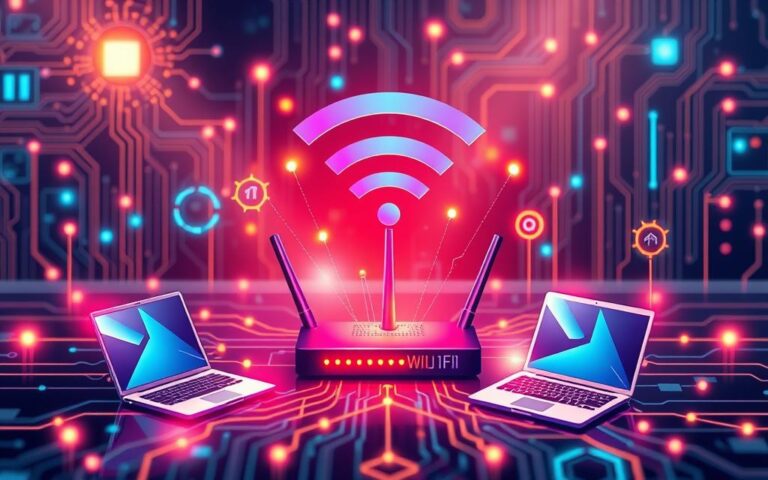Virtual Circuits in Computer Networks: What You Need to Know
Modern network infrastructure relies on logical connections to ensure seamless data transfer. These connections, often referred to as virtual circuits, emulate dedicated physical pathways. They are essential in packet-switched systems like Frame Relay and X.25, enabling reliable communication between devices.
These logical pathways play a critical role in telecommunications, enterprise setups, and VPNs. By creating temporary or permanent connections, they optimize data flow and reduce latency. This makes them indispensable for network administrators and IT professionals.
In this article, we’ll explore how these connections work, the differences between PVC and SVC, and their implementation strategies. Whether you’re managing a small business network or a large-scale telecom system, understanding these concepts is crucial for efficient operations.
What Is a Virtual Circuit in Computer Network?
Efficient data transfer relies on logical connections that mimic physical circuits. These pathways, often called virtual circuits, create a seamless link between two network devices. Unlike physical circuits, they use shared infrastructure to establish a dedicated path for communication.
Definition and Core Concept
A logical connection is a pathway that appears as a dedicated physical link. It enables data to flow smoothly between devices without requiring exclusive hardware. This approach is widely used in protocols like X.25, where resources are reserved during the initial handshake process.
These connections are connection-oriented, meaning they establish a session before data transfer begins. This ensures reliable communication and reduces the need for full addressing in each packet. Instead, header information is used to route data efficiently.
How Virtual Circuits Differ from Physical Circuits
Physical circuits require dedicated hardware links, which can be costly and inflexible. In contrast, logical connections share existing infrastructure, making them more scalable and cost-effective. Here’s a quick comparison:
- Physical Circuits: Use exclusive hardware, ideal for permanent links.
- Logical Connections: Share resources, perfect for temporary or dynamic setups.
By emulating a dedicated path, these logical pathways optimize bandwidth and reduce latency. This makes them a preferred choice for modern networks, especially in telecommunications and enterprise environments.
How Virtual Circuits Work in Modern Networking
Establishing dedicated paths for data transfer is a cornerstone of network efficiency. These pathways, often referred to as logical connections, ensure seamless communication between devices. They operate in three distinct phases: setup, transfer, and teardown.
Connection Setup and Logical Path Creation
During the setup phase, a request is sent from the source to the destination. This process involves assigning virtual circuit identifiers (VCIs) to create a logical path. Each switch along the route updates its table with incoming and outgoing VCIs, ensuring accurate routing.
This phase is critical for defining the path data that will guide packets from source to destination. Once the setup is complete, the network is ready for data transfer.

Data Transfer and Packet Routing
In the transfer phase, data packets are sent using the established VCIs. Intermediate nodes rely on predefined tables to route packets efficiently. This method eliminates the need for complex routing computations, speeding up the process.
An ACK confirmation system ensures reliable delivery. Each packet is acknowledged, confirming its successful receipt. This system minimizes errors and maintains data integrity.
Connection Termination and Session Management
The teardown phase begins once all data has been transferred. A termination request is sent, and switches delete their VCI entries. This frees up resources for future connections.
Time-out mechanisms are in place to handle abandoned sessions. If a connection is inactive for a specified period, it is automatically terminated. This ensures efficient session management and resource allocation.
| Phase | Key Actions | Outcome |
|---|---|---|
| Setup | VCI allocation, table updates | Logical path creation |
| Transfer | Packet routing, ACK confirmation | Efficient data delivery |
| Teardown | VCI deletion, resource release | Session termination |
Types of Virtual Circuits: PVC vs. SVC
Logical pathways in networking come in two primary forms, each tailored to specific needs. These are Permanent Virtual Circuits (PVCs) and Switched Virtual Circuits (SVCs). Understanding their differences helps optimize network performance and cost efficiency.
Permanent Virtual Circuits (PVCs)
PVCs are dedicated, point-to-point connections ideal for stable and consistent communication. They are manually configured, ensuring reliable performance for applications like VoIP and video conferencing. Enterprises often use PVCs for branch connectivity, guaranteeing secure and uninterrupted data flow.
These connections are cost-effective for long-term needs, as they eliminate the need for frequent reconfiguration. However, they require significant upfront investment and maintenance.
Switched Virtual Circuits (SVCs)
SVCs, on the other hand, are temporary and established on-demand. They are perfect for handling bursty traffic patterns, where data transmission rates fluctuate. This flexibility allows organizations to scale resources dynamically, optimizing costs during peak usage times.
Unlike PVCs, SVCs do not require permanent infrastructure, making them ideal for temporary or unpredictable needs. They are particularly useful in environments with rapidly changing requirements.
Many enterprises adopt a hybrid approach, combining PVCs and SVCs to balance stability and flexibility. This strategy ensures reliable performance for critical applications while efficiently managing resources for variable workloads.
Key Advantages of Using Virtual Circuits
Logical connections offer significant benefits for modern communication systems. They enhance performance, reduce costs, and ensure seamless operations. These advantages make them indispensable for both enterprises and service providers.
Reliable Data Transfer and Ordered Delivery
One of the primary benefits is reliable data transfer. These connections maintain path consistency, reducing packet loss by up to 32% compared to connectionless systems. This ensures that data arrives in the correct order, minimizing errors and retransmissions.
For example, in VoIP applications, this reliability ensures clear and uninterrupted voice communication. Such consistency is critical for industries where data integrity is paramount.
Efficient Bandwidth Utilization
Logical connections optimize resource usage through statistical multiplexing. This technique allows multiple data streams to share the same pathway, maximizing efficient bandwidth utilization. It ensures that available resources are used effectively, even during peak traffic periods.
Traffic shaping techniques further enhance this efficiency. By prioritizing critical data, these methods prevent congestion and maintain smooth operations.

Quality of Service (QoS) Prioritization
Another key advantage is QoS prioritization. This feature ensures that high-priority traffic, such as voice or video, receives the necessary resources. For instance, VoIP calls are prioritized over less time-sensitive data, ensuring clear communication.
This capability is particularly valuable in enterprise environments, where diverse applications compete for bandwidth. By managing traffic effectively, QoS ensures optimal performance for critical tasks.
| Advantage | Key Feature | Benefit |
|---|---|---|
| Reliable Data Transfer | Path consistency | Reduced packet loss |
| Efficient Bandwidth Utilization | Statistical multiplexing | Optimal resource usage |
| QoS Prioritization | Traffic management | High-priority performance |
By leveraging these advantages, organizations can achieve enhanced performance and cost efficiency. Logical connections ensure that modern communication systems meet the demands of today’s dynamic environments.
Common Applications of Virtual Circuits
Logical pathways play a pivotal role in diverse industries, enabling efficient communication and data transfer. From telecommunications to enterprise setups, these connections ensure seamless operations and optimized performance. Below, we explore their key applications and real-world implementations.
Telecommunications and Voice over IP (VoIP)
In the realm of telecommunications, logical pathways are essential for delivering clear and reliable voice communications. VoIP systems rely on these connections to reduce jitter and ensure smooth voice transmissions. By maintaining consistent data flow, they enhance call quality and minimize disruptions.
For instance, the packetization process in VoIP systems benefits from logical pathways, as they prioritize voice packets over less time-sensitive data. This ensures that conversations remain clear, even during peak network usage.

Enterprise Networks and Branch Connectivity
In enterprise networks, logical pathways are widely used to connect multiple locations securely. They enable efficient branch connectivity, ensuring that data flows seamlessly between headquarters and remote offices. Technologies like MPLS (Multiprotocol Label Switching) are often employed to optimize these connections.
Financial institutions, for example, use logical pathways to securely transmit sensitive data across branches. Similarly, healthcare organizations rely on these connections to ensure fast and reliable transmission of patient records. These implementations highlight the versatility and importance of logical pathways in modern enterprise environments.
| Industry | Application | Benefit |
|---|---|---|
| Telecommunications | VoIP Systems | Jitter reduction, clear voice calls |
| Enterprise Networks | Branch Connectivity | Secure data transfer, seamless operations |
| Financial Institutions | Data Security | Protected sensitive information |
| Healthcare | Patient Records | Fast and reliable transmission |
By leveraging logical pathways, organizations across industries can achieve enhanced performance and operational efficiency. These connections remain a cornerstone of modern communication systems, addressing diverse needs with precision and reliability.
Virtual Circuits vs. Packet Switching: Key Differences
Communication systems rely on distinct methods to ensure efficient data delivery. Two primary approaches are logical pathways and packet switching. While both aim to optimize data transfer, they differ significantly in their mechanisms and applications.
One of the key differences lies in addressing requirements. Logical pathways use Virtual Circuit Identifiers (VCIs) to route data, simplifying the process. In contrast, connectionless systems like packet switching require full addressing in each datagram, increasing overhead.

Error handling also varies. Logical pathways ensure reliability through predefined paths and acknowledgment systems. Packet switching, however, relies on end-to-end error detection, which can lead to higher retransmission rates.
Latency characteristics differ as well. Logical pathways minimize delays by maintaining consistent paths, while packet switching may experience variable latency due to dynamic routing.
Here’s a quick comparison of their suitability for different use cases:
- Logical Pathways: Ideal for applications requiring reliability and low latency, such as VoIP and video conferencing.
- Packet Switching: Better suited for scalable, dynamic environments like the internet, where flexibility is crucial.
Performance metrics further highlight these differences. Logical pathways ensure consistent throughput and reduced packet loss, while packet switching excels in scalability and resource efficiency.
By understanding these distinctions, network administrators can choose the right approach for their specific needs, optimizing performance and cost-effectiveness.
Step-by-Step Guide to Implementing Virtual Circuits
Implementing logical pathways requires a structured approach to ensure seamless communication and optimal performance. This process involves careful planning, precise configuration, and ongoing monitoring. By following these steps, organizations can achieve efficient and reliable network operations.
Network Design and Planning
Effective network design begins with capacity planning. Organizations must assess current and future demands to allocate sufficient resources. A hybrid approach, combining top-down and bottom-up methodologies, ensures alignment with business goals and technical requirements.
Tools like PRTG Network Monitor and SolarWinds Network Topology Mapper are invaluable for visualizing network layouts. These tools help identify potential bottlenecks and optimize resource allocation. Proper planning minimizes downtime and enhances scalability.
Configuration and Virtual Circuit Identifiers (VCIs)
Configuring logical pathways involves assigning VCIs to establish unique connections. Sequential allocation simplifies management, while categorization by service type enhances efficiency. For example, specific VCI ranges can be reserved for voice, video, and data traffic.
Documenting VCI assignments is crucial for troubleshooting and maintenance. Regular audits ensure that allocations align with current network needs, preventing resource wastage. This practice is particularly important in large-scale environments.
Monitoring and Optimization Techniques
Ongoing monitoring is essential for maintaining performance. SNMP configurations enable real-time tracking of critical metrics like bandwidth utilization and device uptime. Setting up traps provides instant alerts for potential issues, allowing prompt resolution.
Optimization techniques, such as traffic shaping and QoS tuning, further enhance network efficiency. Assigning bandwidth limits and prioritizing critical traffic ensures smooth operations during peak usage. These strategies are vital for maintaining quality of service in dynamic environments.
| Step | Key Actions | Outcome |
|---|---|---|
| Design | Capacity planning, network mapping | Scalable and efficient layout |
| Configuration | VCI allocation, documentation | Reliable and traceable connections |
| Monitoring | SNMP setup, trap configuration | Proactive issue resolution |
| Optimization | Traffic shaping, QoS tuning | Enhanced performance and reliability |
By following this guide, organizations can implement logical pathways effectively, ensuring robust and efficient network operations. For more detailed insights, refer to the Wikipedia page on virtual circuits.
Challenges and Limitations of Virtual Circuits
While logical pathways offer numerous benefits, they come with specific challenges that organizations must address. From hardware demands to recovery strategies, understanding these limitations is crucial for effective implementation.
Equipment Requirements and Scalability
One of the primary challenges is the equipment requirements. Setting up logical pathways often demands specialized hardware, which can increase upfront costs. For instance, devices like routers and switches must support specific protocols, adding to the complexity.
Scalability is another concern. As networks grow, maintaining consistent performance becomes harder. Unlike Software-Defined Networking (SDN), which offers dynamic resource allocation, logical pathways may struggle to adapt to rapidly changing demands.
To mitigate these issues, organizations can adopt redundancy strategies. Implementing backup systems ensures uninterrupted operations, even during hardware failures or peak usage periods.
Re-establishment After Network Failures
Network failures pose significant challenges for logical pathways. On average, failed Permanent Virtual Circuits (PVCs) take up to 48 hours to recover. This downtime can disrupt critical operations, especially in industries like finance or healthcare.
Session persistence is another hurdle. When a failure occurs, re-establishing connections can be time-consuming. Failover mechanisms, such as automatic rerouting, help minimize disruptions but require careful configuration.
Organizations must also consider the cost of implementing these solutions. While redundancy and failover systems enhance reliability, they add to the overall expenditure.
By addressing these challenges, organizations can optimize their use of logical pathways. Proper planning and strategic investments ensure that these systems deliver consistent performance, even in demanding environments.
Virtual Circuits in Frame Relay and X.25 Networks
The evolution of networking technologies has seen significant milestones, from early implementations to modern advancements. Among these, X.25 networks and Frame Relay stand out as foundational technologies that shaped the way data is transmitted across wide area networks (WANs).
X.25, developed in the 1970s, was one of the earliest packet-switched protocols. It provided reliable data transmission, making it a cornerstone of legacy systems. However, its limitations in speed and scalability became apparent as data traffic grew. This paved the way for Frame Relay in the 1990s, which offered higher bandwidth and lower latency.
Frame Relay became a dominant technology for WANs, connecting remote offices and branch locations efficiently. Its ability to support multiple logical pathways over a single physical link made it a cost-effective solution for enterprises. Despite its success, the rise of Multi-Protocol Label Switching (MPLS) in the late 1990s marked a shift toward more scalable and flexible networking solutions.
Modernizing from these legacy systems presents challenges. Compatibility issues, infrastructure upgrades, and staff training are common hurdles. Organizations must also ensure security during the transition, as newer protocols may introduce vulnerabilities.
Error correction approaches vary across these technologies. X.25 relied on robust mechanisms, retransmitting data until successful delivery. Frame Relay, on the other hand, minimized error correction, assuming higher-layer protocols would handle it. MPLS focuses on efficient data forwarding, leaving error correction to underlying protocols like TCP/IP.
| Technology | Key Feature | Limitation |
|---|---|---|
| X.25 | Reliable data transmission | Low speed and scalability |
| Frame Relay | High bandwidth, low latency | Limited error correction |
| MPLS | Scalable and flexible | Complex implementation |
Migrating to modern protocols requires a structured approach. Organizations should assess their current infrastructure, plan the transition, and conduct pilot testing. Training staff and optimizing the network post-deployment are also critical steps.
Understanding the historical context of these technologies helps organizations appreciate the advancements in modern networking. While X.25 and Frame Relay laid the groundwork, MPLS and other contemporary solutions continue to drive innovation in the field.
Future Trends in Virtual Circuit Technology
Emerging technologies are reshaping how networks handle data, driving innovation in connectivity. From SDN integration to advancements in 5G networks, the future of logical pathways is poised for transformation. These trends promise enhanced efficiency, scalability, and adaptability for modern communication systems.
One significant development is the synergy between logical pathways and software-defined networking. SDN allows for dynamic resource allocation, enabling networks to adapt to changing demands in real-time. This integration simplifies management and reduces operational costs, making it a key focus for enterprises.
The rise of 5G networks is another game-changer. Technologies like Virtual 5G Virtual Circuit enhance performance, ensuring consistent speeds even during network fluctuations. This capability is crucial for applications requiring low latency, such as autonomous vehicles and remote surgery.
Cloud-native implementations are also gaining traction. By leveraging cloud infrastructure, organizations can achieve greater flexibility and scalability. This approach supports distributed environments, making it ideal for global enterprises and IoT ecosystems.
Artificial intelligence is playing a pivotal role in optimizing traffic management. AI optimization techniques analyze network patterns, predict congestion, and allocate resources efficiently. This ensures smooth operations, even during peak usage periods.
Finally, the demand for IoT scalability is driving innovation. With billions of devices expected to connect in the coming years, logical pathways must handle massive connectivity demands. Advanced protocols and technologies are being developed to meet these challenges.
| Trend | Key Feature | Impact |
|---|---|---|
| SDN Integration | Dynamic resource allocation | Simplified management, cost efficiency |
| 5G Networks | Low latency, consistent speeds | Enhanced performance for critical applications |
| Cloud-Native Implementations | Flexibility, scalability | Support for distributed environments |
| AI Optimization | Traffic prediction, resource allocation | Smooth operations during peak usage |
| IoT Scalability | Massive connectivity | Support for billions of devices |
These trends highlight the evolving landscape of logical pathways. By embracing these advancements, organizations can stay ahead in an increasingly connected world.
Conclusion
As technology evolves, the role of logical connections in modern communication systems becomes increasingly vital. These pathways ensure reliable data transfer, enhance quality of service, and optimize resource utilization, making them indispensable for today’s network infrastructure.
Hybrid networks, combining on-premises and cloud solutions, highlight the ongoing relevance of these connections. They provide flexibility, scalability, and robust security, addressing the dynamic needs of enterprises and service providers.
For successful implementation, organizations should focus on comprehensive planning, clear governance, and continuous monitoring. Emerging technologies like AI, 5G, and edge computing are shaping future implementations, offering new opportunities for innovation and efficiency.
In summary, understanding these key takeaways ensures that businesses can leverage logical pathways effectively. By adopting best practices and staying ahead of technological trends, organizations can achieve seamless communication and operational excellence.
FAQ
How does a virtual circuit differ from a physical circuit?
A virtual circuit creates a logical path for data transmission between two devices, unlike a physical circuit, which requires a dedicated physical connection. This logical path allows for more flexible and efficient data transfer across networks.
What are the main types of virtual circuits?
There are two primary types: Permanent Virtual Circuits (PVCs) and Switched Virtual Circuits (SVCs). PVCs are pre-configured and always active, while SVCs are dynamically established for specific sessions.
Why are virtual circuits considered reliable for data transfer?
Virtual circuits ensure reliable data transfer by maintaining a consistent path for data packets from source to destination. This reduces packet loss and ensures ordered delivery, making them ideal for connection-oriented services.
How do virtual circuits improve bandwidth utilization?
By sharing network resources efficiently, virtual circuits optimize bandwidth utilization. This allows multiple connections to coexist without requiring dedicated physical links, enhancing overall network performance.
What role do virtual circuits play in Frame Relay networks?
In Frame Relay networks, virtual circuits provide a cost-effective way to establish connections between devices. They enable efficient data transmission by using logical paths instead of physical ones.
What challenges are associated with virtual circuits?
Challenges include equipment requirements, scalability issues, and the need to re-establish connections after network failures. These factors can impact session management and overall network reliability.
How are virtual circuits implemented in enterprise networks?
In enterprise networks, virtual circuits are used for branch connectivity and secure data transfer. They provide a scalable solution for linking multiple locations while ensuring efficient traffic management.
What future trends are shaping virtual circuit technology?
Emerging trends include integration with software-defined networking (SDN) and advancements in Quality of Service (QoS). These innovations aim to enhance scalability, performance, and adaptability in modern networks.














